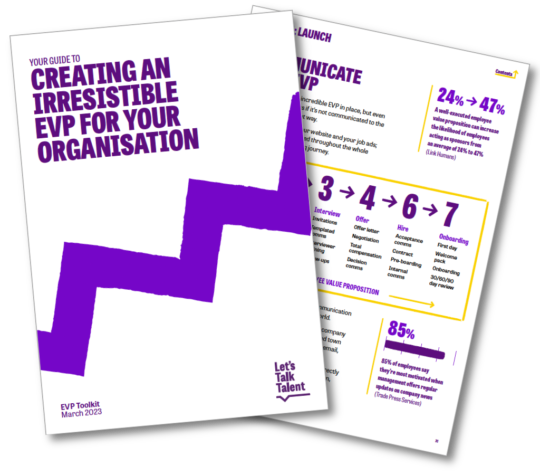How EVP and CVP intersect: Making sure you attract the people you need to deliver your customer strategy
We’ve established how important a compelling employee value proposition (EVP) can be for your talent attraction and retention efforts. A well-crafted EVP can have a huge impact on your bottom line, as well as contribute to attracting high potential candidates to your organisation.
It can also help convince them to stay after the onboarding period is over! It can be the difference between having the people you need on your bench to deliver your long-term strategy, and spending all your time and energy on trying to fill positions left vacant by departing employees.
But an EVP is not a marketing gimmick you use to sell the dream of working with you, or something you use to paper over the cracks. (Find out what an EVP is here)
A successful EVP should ring true from the inside out, and reflect the reality of working for your organisation. More than that, it should be perfectly aligned with your customer value proposition (CVP).
As Jo Taylor, MD at Let’s Talk Talent, says: “You can’t have a business strategy and not think about the people who will deliver it at the other end.”
However, if your EVP and your CVP both have different audiences and purposes, how can you make sure they work together? And what happens when your employee promise doesn’t match your external consumer brand?
Understanding the difference between EVP and CVP
The difference between your EVP and your CVP is simple: your EVP illustrates why people should work for you, while your CVP describes why people should buy from you.
However, nothing is ever this clear-cut, so let’s dive into the specifics.
Your EVP is owned by HR and represents the contract between the organisation and its employee. It highlights what the business has to offer, and what it expects of its people in return.
Your EVP is quite wide-ranging and covers everything from your culture, your mission, your values, the career progression and training opportunities you offer… right down to the dress code and the hours staff need to keep. In short, everything a person should know to determine if what you provide, and what they have to do, matches their values, their career goals, and their lifestyle.
Your CVP, on the other hand, is created by Marketing with your customers in mind. It tells the world what makes your products, your brand, and your company, truly unique. It speaks in terms of market differentiators, rather than employee benefits.
However, that’s where the differences end. When you look at it, both your customer and employee propositions are used to demonstrate why someone should choose you over your competitors.
Your EVP and your CVP are equally important. They also have to work together in order to create strong advocates. This requires a deep understanding of your audience’s wants and needs.
Aligning your internal and external offering can benefit your recruitment and retention efforts as well as your sales, all of which can positively impact your bottom line. “Don’t forget that your future talent may come from your customer pool, and vice versa,” says Jo.
The benefits of linking employee (EVP) and customer value (CVP) propositions
Companies that link their EVP and CVP tend to attract the kind of people that are aligned to their purpose and values. This, in turn, leads to staff remaining loyal to a business they identify with, which in turn generates innovation and growth, thanks to their higher motivation and energy levels.
Internal advocates are eager to contribute to the organisation’s performance and, as such, tend to work hard to come up with the kind of product innovations that will delight your customers.
Refining your EVP and your CVP to create alignment will also lead to attracting people who love your brand, and will want to work for you. Not only are they keen to be a part of something they love, they also see themselves reflected in your internal culture.
Lego is a great example of this. The entire recruitment process has a playful element to it (with potential candidates asked to build something out of Lego), and the feedback from past and current employees confirms that it’s a great place to work. What’s not to like?
Have a look at some other examples of EVPs that work.
Can a misaligned EVP and CVP impact your organisation?
Yes, it can. We’ve all heard stories of businesses offering a great customer experience whilst employees report a toxic culture at work. Companies cannot hide a negative employee experience, as feedback mechanisms such as company review sites bring this information to light.
And, whilst a clunky employee experience may not have a huge impact on external customers buying your brand in the short-term, it may lead to a talent drain. Businesses could struggle to attract talent, or to retain existing staff, which does impact growth.
Lack of innovation could eventually start to affect market positioning, with high recruitment costs also driving down profit margins.
Is the reverse true? Will bad customer service stop people from wanting to work for you? Again, this could indeed be one of the long-term impacts of a misaligned EVP and CVP.
Customers want to feel connected to the brands they are buying from. When they feel part of an organisation’s family, they spread the word and become strong advocates.
A bad experience, on the other hand, could have them turn away from your brand altogether, and stop them from looking into a potential career with you.
Developing a compelling EVP and CVP
Whether you’re aware of it or not, you already have both a CVP and an EVP, and both are crucial for your talent strategy, as well as your sales figures.
HR departments do need to work with their Marketing counterparts to create a strong employee and customer proposition that work together, and optimise it on a regular basis. “It’s about being intentional about your messages, and optimising them as you go along,” concludes Jo.
In order to achieve this, data will be key. Gather feedback on what you’re doing well and what you could improve, and start from there. Find out where things aren’t running smoothly, both as part of your employee and customer experience, and endeavour to fix it.
But don’t stop at the negatives. Find out what attracts people to buy from you, or to work with you, and amplify it.
If you feel your organisation could benefit from an audit of your employee value proposition, don’t hesitate to book a call with us. You can also purchase our EVP toolkit, or visit our EVP services page for some free resources.
Related EVP resources:
- Buy our EVP Toolkit to help you get started [Paid Resource]
- Building an Employee Value Proposition (EVP) that attracts and retains top talent [Podcast]
- What makes a good EVP and who does them well? [Podcast]
- 5 trends in employee value proposition (EVP) for 2023 [Blog]
- What is an Employee Value Proposition (EVP) & why do you need one? [Blog]
- Employee Value Proposition (EVP) examples that work [Blog]
- 4 ways to write a winning Employee Value Proposition (EVP) [Blog]

